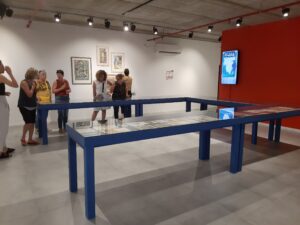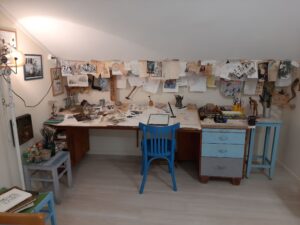An exhibit of the works of Shraga Weil (1918-2009), a once-prominent Israeli artist who has receded somewhat from popular memory, brought us this week to the rural Emek Hefer. Weil, a Holocaust survivor who studied art in his native Czechoslovakia and Paris, was a multifaceted artist and graphic designer. The exhibition at Zuzu Gallery focuses on his graphic works, some of which are in the collection of Yad Ya’ari, the archive of HaShomer HaTzair, and others from the Weil family collection.

At the exhibition, the artist’s daughter Efrat told us that she and her husband had recently opened the “Atelier of Shraga” [studio, in French] in a part of the former dining hall of the nearby Kibbutz HaOgen to showcase her late father’s work. Although usually only open on weekends, in a serendipitous coincidence the gallery was open that afternoon, and there we were delighted to discover a treasure trove of his works.
Kibbutz HaOgen was founded by members of HaShomer HaTzair from Czechoslovakia in 1939. Weil and his wife, already connected to that youth movement in Europe, managed to survive the war in the border regions between Hungary and Slovakia, and ultimately settled on the kibbutz in 1947, after a stint in the Cyprus detention camps. Today, the kibbutz, like many others, is privatized.
Weil is primarily known in Israel for his graphic works, mostly in black and white. Weil’s “kibbutz job” was illustrating books for Sifriat HaPoalim [The Worker’s Library] in Tel Aviv, except on weekends, when he would be required to wash dishes in the kibbutz dining hall. His posters, book jacket images, and illustrations for both adult and children’s books reached a wide audience in Israel. He also designed doors for the Knesset and the President’s House. In his later years, he achieved a measure of commercial success for the prints he did for the Safrai Gallery, many of which adorned Jewish homes in the US.
This month’s exhibit at the Atelier, “Testimony and Remains,” depicts the artist’s experiences and those of others during the Holocaust. But besides the stark images, the exhibit includes a loving recreation of Weil’s studio, including his desk, a charming mural of Noah’s Ark that he designed and painted for the children’s house, and other mementos, such as documents, aphorisms, photographs, furniture (some his own work), and more.

The works in the exhibit at the Zuzu Gallery capture the early years of Zionist idealism. The virtues of kibbutz life in general, and working the land specifically, come across in the paintings and drawings’ clean lines and pure colors. Works on view include oil paintings, posters, and book jackets, as well as illustrations for the Song of Songs, the kibbutz edition of the Passover Haggadah, and the story of Samson. A charming series of three ink drawings depicts the quandary of the artist confronting the blank canvas. Also on view are later lithographs which incorporate richly-colored collage and a variety of printing techniques that invite closer examination and interpretation.

If you are interested in the art of Israel’s early years, make the trip to Emek Hefer; it’s well worth the visit.
The current exhibit at the Atelier is open on Friday and Saturday from 10:00 -14:00 until July 1st.
The exhibit at the Zuzu Gallery runs until July 8th.
